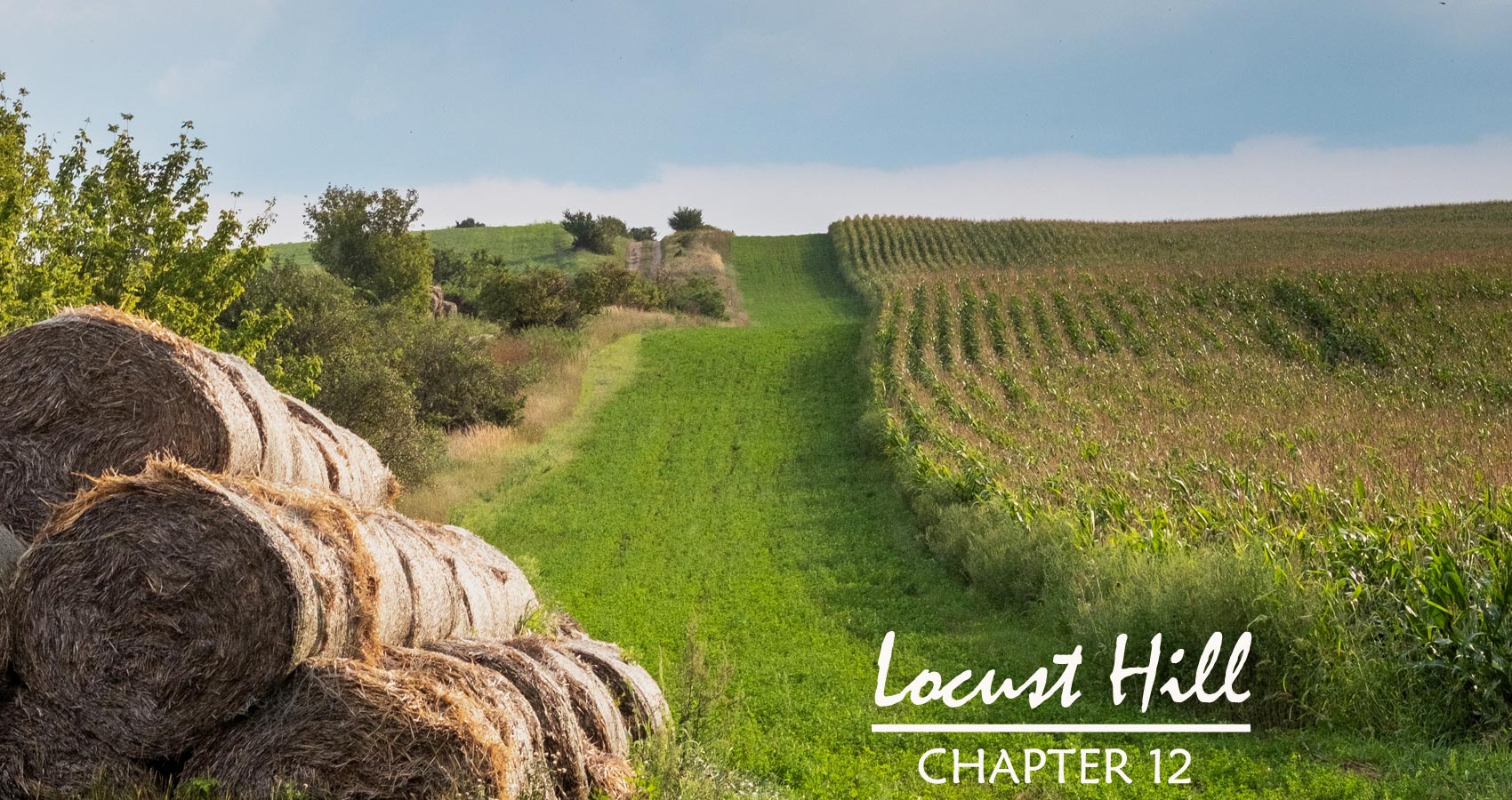Locust Hill
Chapter XII
Farewell
written by: Carl Parsons
12.1
When winter comes to Locust Hill the western horizon is lined with the silhouettes of the many deciduous trees that dominate this land—slender dark columns set against the early evening sun, with their intricate patterns of trunks and thickets of bare branches—relieved only by the occasional dark pyramids of the pines or the squat glossy holly bushes with their bold red berries reflecting the last light of day. Most of the outdoor farm work ceases by then, but not all. Compost is still spread to rot in the winter rains, returning its nutrients to the soil. In some plots we sow fall cover crops of winter rye or hairy vetch or crimson clover. But mostly the soil rests as the ancient rhythm of agriculture requires. Besides, in the barns equipment needs repairing and cleaning. The greenhouses still bustle with the cultivation of herbs and cold-weather crops, and in the warm, humid, dark rooms of our homestead barn mushrooms still grow. The hens and ducks and guineas still nestle into the straw beneath their heat lamps. Inside our home we sift through the data from the past growing season and make our plans for the next. How can our successes be extended into the New Year and the Old Year’s failures avoided? What new opportunities await us? How will the Russell Farm Alliance fare in this New Year? It is the time of planning for farmers—that’s what winter is, and so much depends on it.
When winter comes to Locust Hill, the pool at the bottom of the hill behind the heritage farm on Lost Creek freezes over on the coldest days and the grasses along the path down the hill become slippery with frost and break under footfall with a crunch. Jim and I would still go there, though, especially on sunny winter days, carefully descending the footpath now made more treacherous by our advanced age. We would even dare to sit on the now rickety log bench where Jim proposed to me and recall all that had happened in our lives together.
12.2
After Russell Farms became known as an area leader in agri-business, Jim and I were sometimes invited to speak at conferences around the state at which we explained some of the practices we used to build the Alliance into a success. I typically spoke about the importance of record keeping and the use of new information technology and statistical inference for making decisions about farming, while Jim usually spoke about the need for small acreage farmers to combine their resources in various types of partnerships to share resources, reduce costs, and boost production to a level competitive with the industrial farms.
One time just after we retired, Jim was called upon to speak at a conference in Charleston on the future of farming in West Virginia. I kept a copy of that speech because I thought it was his best. In it he claimed that, in order to survive, farmers today must optimize every aspect of farm production or else risk slipping gradually back into subsistence farming. Near the end of his talk, he summarized the means for improving performance:
Optimize the use of space by intensive planting, use dwarf crop varieties where necessary, and specialty agro-buildings; optimize soil health by enriching the soil with compost, feeding it with natural fertilizers only; optimize profits by resource sharing in partnerships and by an unflagging daily discipline that detects and eliminates problems when they are still small.
Then he concluded with the key principle that had guided us through our years of farming:
More than anything else, today’s farmers must work with Nature, not against her. This has always been true. The ancient Greeks knew it, for Hesiod recounts in his Works and Days the purposes of the days of each season and then concludes that properly aligning his work with these days, as appointed by the gods, makes a farmer both happy and prosperous. Likewise, though centuries later, the Roman poet Vergil writes:
I obey these eternal laws and limits most certain,
Imposed by Nature upon each place from time primeval.
[Continuo has leges aeternaque foedera certis
Inposuit natura locis, quo tempore primum.
– The Georgics, I.60-61]
Finally, even the creator of the Scientific Revolution, Sir Francis Bacon, warned as early as 1620 that ‘nature, to be commanded, must be obeyed.’ But in order for us to work with Nature, we must know Nature and know her well: Know the soil we till, know the crops we grow and even the weeds we fight, know the effects of the weather patterns, know the materials and technologies we use, and know the true value of the food we produce to feed the world—both in terms of its nutritional value on the consumer’s table and in the dollars our crops represent for us in the marketplace.
All this means a lifetime of ongoing learning for today’s farmers. It also means careful data collection and record keeping. I fully realize that not every farmer is as lucky as I am to have a beautiful wife who has diligently learned both to gather and apply data using information technology to optimize our farming operations. However, even a homely, bespeckled, green-visored accountant will do. But somehow the information must be gathered—and applied.
For what Hesiod and Vergil knew from the lore and legend of their ancient religions, we must know today from the hard data of science. Their variable and capricious gods are now our variable and capricious growing conditions and constantly changing (and annoying) government regulations. They used timely sacrifices and songs to appease their angry gods; we hope to use technology and greater knowledge to outwit them.
And here is exactly the problem: We believe that technology can solve all of our problems. It can’t—at least not when that technology works against Nature. For example, not long ago we thought that synthetic fertilizers would enrich our soil; today we know that over time they deplete the soil instead, eventually rendering it worthless.
The world population grows by over 80 million new people per year. How will this year’s 80 million new children be fed? We know we must continue to optimize all aspects of what we do as farmers, as I outlined earlier. And with such a daunting challenge before us, we also know that we must use technology to succeed. What I am insisting on is simply this: That technology must work with Nature, not against her. We need technology to optimize natural processes, not substitute artificial processes for them.
You may be thinking that I am now contradicting myself since I earlier spoke about converting old warehouses to agro-buildings in which we could grow at least some types of smaller crops in vertically arranged sets of cubicles that rise twenty feet or more to the ceiling. As I said, these would be carefully monitored and adjusted automatically for lighting, moisture, and temperature, based on our knowledge of Nature, in order to always ensure ideal growing conditions.
Such growing systems, however, are not a contradiction of Nature any more than a greenhouse is. Instead, they are a necessary optimization of natural processes that will allow us to grow crops inside the very cities that we serve. The farmer attending such a building might well look more like a lab technician in a white lab coat than the traditional farmer with the traditional bib overalls and bright red bandana about his neck, but the outcome of his labor is more important than conformance to a stereotype, no matter how old and dear that stereotype is to us.
Finally, to meet this great challenge and still survive as farmers, we must work together. Few of us, especially in West Virginia, where most farms are of necessity quite small, can afford all of the new technology that we will need. But by working together with shared resources, in partnerships organized either by area or by crop type, we can share expenses, share technology, share best practices, and thus not only survive but prosper. I feel certain that we can do this. A far greater concern for me is the uncertain impact of moving crop production indoors to place it under highly controlled, artificial conditions. I don’t fear that it won’t work; I do fear what it may do to us as human beings when we no longer touch the soil.
I was especially proud of Jim that night, but then I was always proud of him.
12.3
After years of both struggles and successes, Jim and I finally retired. Turning leadership of the Russell Farm Alliance over to JJ and Nathan, we moved back to the homestead farmhouse, which several of our children had used as a starter home for their families. It had been remodeled and modernized several times, but still preserved its pioneer charm and still contained its original wood-burning stove. The farmhouse had long maintained a sentimental hold on our entire family, so it seemed only fitting that we should move back there in retirement.
We still kept a small vegetable garden near the house that Jim and I puttered in daily while JJ and Nathan and various farmhands worked the surrounding fields each season as Russells had done now for nearly 150 years.
Five years after we had returned to the homestead, on a warm spring day, Jim went out to spread compost on our little garden and till it into the soil. He had been outside for about three hours, but I still hadn’t heard the tiller and he hadn’t returned for our midmorning coffee together as he usually did, so I went to check on him. I called out for him from the porch. No answer. So, I clanged the triangle as loudly as I could since he often wandered down towards the woods. Still no answer. Then I became alarmed and hurried around the back of the house to the garden on the other side. And there I saw him. He was face down in the soil, not moving but clutching some of the dark rich dirt in his right hand. He was lying near the same spot where his father had died.
When I went to him, he didn’t respond, though he still had a faint pulse, so I rushed back to the house and frantically called 911, snatched an old quilt, and hurried back to the garden. I covered him and lay beside him in the dirt with my arms around him and my face on his back. I wept and wept. But Jim’s spirit now seemed to hover just over me, saying, “It’s all right, Cassie. This day had to come, but it’s all right.” When the emergency responders arrived, they told me what I already knew; no pulse now; they guessed a heart attack. Then I brushed the dirt from my clothes and called JJ and Catherine, both of whom quickly came to be with me while JJ’s wife called the rest of the family.
12.4
Jim’s funeral was one of the largest the funeral home had ever conducted they told me. JJ and Nathan canceled work at all the farms so that our employees could attend if they wished, and nearly all did. In addition to our many friends and fellow parishioners, local vendors and customers also attended as well as some of the city and county officials. At the Requiem Mass in St. Benedict’s, JJ bravely eulogized his father without his voice faltering even once. The cortege to the cemetery was long and solemn.
After the funeral, we held a wake at the heritage farmhouse. Cars were parked all along its winding driveway, where the blueberry bushes were beginning to blossom. The cars stretched from the old carport clear out to the entrance on Ridge Road. The women in our family prepared all the food. It was mostly our Locust Hill neighbors who attended the wake. As they milled about, both indoors and out, I sat in their midst receiving their condolences and kind wishes. Wanda came with her family; Javier and Rita with theirs. Even the Lowerys stopped by to pay their respects along with so many other people some of whose names I didn’t even know. I thought how wonderful a place Locust Hill is, with such people as these living in it.
But most of all, I thought about Jim, more clearly than ever before. I realized that he—even more than being my husband and our children’s father—that he was the spirit of Locust Hill. Or rather, he mediated that spirit for the rest of us, his family and our neighbors too—by his reverence for the details of its nature, its birds, its trees, its wildflower, even its weeds—by reading its skies and testing its soil on his tongue—even by the way he strode across its fields on his way to plough and plant its fields. To us, he was the embodiment of that spirit, the one person who could make it speak in a human language, to show us its fear and anger when it was threatened, and to laugh and rejoice with us when it renewed itself each spring. That is how I remember Jim.
Several weeks after his funeral I took the old photo album from its cabinet in the living room, carried it into our bedroom, and placed it on the desk where I first began to keep our farm records. I opened the album to the page we had started when Jim and I first married, took out our best pen, and, as neatly as I could, added this entry below our wedding picture:
James Ray Russell (1946 – 2015) married Cassandra Leigh Clark (1946 – ) of Parkeston in June 1968. Their children were James II, Catherine, Nathan, Samuel, and Carolyn.
12.5
Now, after tending our garden each day by myself, I sit alone in this old farmhouse well into the evening, thinking about my life with Jim and about just how lucky I’ve been. Since all our children have stayed in Locust Hill or close by, I have many grandchildren to spoil, which I am both careful and grateful to do, although many of them are grown by now, too. I see at least one of them every day, usually more than one. Occasionally, some of them even stay with me overnight. Sometimes I see Sandie and Freddy too and their children. In contrast, so many of my friends rarely see their children or grandchildren at all for they have become ghosts, flown away from our West Virginia’s hills and shadowed hollows. My family, thankfully, is still right here. In that respect, as in so many others, I am truly blessed.
Still, some days seem impossibly difficult for me without Jim. At St. Benedict’s, friends say they still imagine seeing him sitting next to me. At times I think that I feel him there too during the Mass touching my arm or helping me hold the Missal. At home I sometimes see him walking across the fields of our farms or kneeling in the garden next to this old farmhouse even though I know he’s not really there.
Now the lengthening days of spring gradually push back the winter’s darkness. And as I prepare for bed, the last of the late spring sunlight bends low to peer under the curtain into our bedroom as though searching for an old friend it has missed in the fields. At this moment I can still hear Jim say, “It’s all right, Cassie. It’s all right.”
The End
- Locust Hill: Chapter XII - May 7, 2023
- Locust Hill: Chapter XI-II - April 6, 2023
- Locust Hill: Chapter XI-I - March 5, 2023



